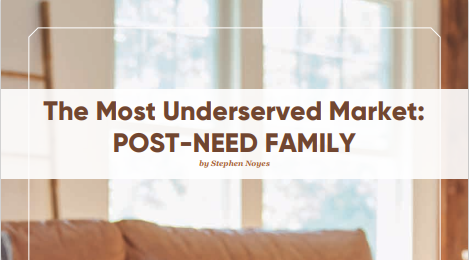(404) 312-6640
The Most Underserved Market: POST-NEED FAMILY
According to a 2022 CANA survey, in the United States, an estimated 21.9 million families hold cremated remains in their homes. With the ever-increasing cremation rate, with some reports projecting we will reach 80% nationally in the next twenty years, the number of urns at home is only expected to increase. However, an urn at home doesn’t mean those urns are an urn of value or that families have plans for a permanent place of memorialization for their loved ones. Keeping an urn at home is not permanent memorialization. Only 68% of urns at home are in an urn of value, leaving a considerable number in temporary, often overlooked containers. Our industry has traditionally focused efforts on servicing pre-need individuals and at-need families. We know that a critical and largely neglected segment is the post-need group: families who already have cremated remains at home, frequently stored in less-than-ideal conditions, and maybe only plan on keeping the urn for a generation before not knowing what to do with it.
By reaching out to post-need families we can address the emotional and practical needs of these individuals, ensuring that their loved ones’ remains are preserved in a manner that honors their memory. Moreover, this shift in focus presents a significant revenue opportunity for our industry, transforming a currently underserved market into one of meaningful engagement and growth. Permanent Memorialization should help families choose what to do with their loved ones. By enhancing our approach to post-need families, we can reduce the number of urns relegated to attics, closets, and the dreaded thrift store donation bin. This fosters a more respectful and financially beneficial relationship with the families we serve.
WHY DO FAMILIES HAVE CREMATED REMAINS AT HOME?
Several factors contribute to the presence of cremated remains in American households. One significant reason is the rising popularity of direct cremation (Direct Cremation Return To Family, AKA DCRTF). This option is often more affordable and perceived as simpler compared to traditional funerals. However, the direct nature of this service can leave families unprepared for what to do with the cremated remains afterward, leading to a higher likelihood of the ashes remaining at home. Direct cremation shouldn’t end with, “Here are the cremated remains back” or “Here is the urn back”.
Inheritance also plays a critical role. Many people find themselves in possession of cremated remains after the death of a relative who was holding onto another loved one’s remains. Often, inheritors might not know what other options are available than to simply keep these urns in storage in their home. The perceived responsibility to care for the remains can make it difficult for families to seek out information on a permanent resting place.
Educational gaps within the industry exacerbate this issue. According to recent studies, 60% of Baby Boomers wish they knew more about what to do with cremated remains. This lack of information is even more pronounced among younger generations, with three out of four Millennials expressing a desire for better guidance. Without clear instructions or uderstanding of their options, families often default to keeping the remains at home, unsure of the next steps.
Interestingly, the emotional response to having cremated remains at home varies significantly by age. Over half of Baby Boomers find comfort or joy in having their loved one’s remains close by, viewing it as a way to maintain a tangible connection. In contrast, only one in three Millennials share this sentiment. Younger generations may feel less comfort from the physical presence of the remains and more confusion or even discomfort due to the lack of clear direction and the transient nature of their living situations. This generational difference highlights the need for targeted education and support to help all families make informed decisions about the final resting place of their loved ones’ remains. Especially as direct cremation further pushes this opportunity for educating families away from our influence.
WHO HAS CREMATED REMAINS AT HOME?
The demographic distribution of those who keep cremated remains at home reveals insightful patterns. A significant portion, 39%, are the children of the deceased, reflecting the fact that the majority of children are not involved in their parents’ death care decisions, according to the CANA survey. Another 30% of individuals holding onto cremated remains are extended family members or friends, most likely through inheritance of those who did not have plans completed beyond the cremation. Spouses only accounted for 14% of the urns at home.
Whether it is an adult child, friend, spouse, or other loved one keeping an urn at home, what happens to that urn once that person dies? Sometimes there is a direction to inter in a cemetery or scatter, but often another person inherits the urn. The cycle continues, each time most likely going to someone less and less connected to the person’s remains that are in that urn. This is where the horror stories we hear about urns ending up on thrift store shelves, garage sales, or the garbage.
WHAT SHOULD WE DO ABOUT THIS?
Addressing the needs of families with cremated remains at home requires a proactive approach from our industry, including funeral directors, cemeteries, and vendors. One critical step is to educate families about the various urn options available, particularly emphasizing those designed for home display. Currently, one in five urns at home are in temporary containers, which are neither aesthetically pleasing nor suitable for long-term storage. By informing families about the benefits and availability of decorative and durable urns, the industry can help them become more informed and provide real comfort to families.
In addition to improving urn options, the industry should provide comprehensive education on other disposition methods. This includes educating families about burial options, columbarium niches, and the regulations surrounding the scattering of cremated remains. Many families are unaware of these alternatives and the legalities involved, leading to indecision and inaction. By offering clear, accessible information and guidance, the industry can help families make informed decisions that align with their personal and cultural preferences.
Furthermore, it is crucial to discuss the potential consequences of not making a permanent plan for cremated remains. Informing people that they should have plans from cremation to urn to permanent memorialization. Families need to understand what can happen if remains are left in home storage without a clear plan, such as the risk of the urn being misplaced or neglected over time. By highlighting the importance of making a thoughtful, long-term decision, the death care industry can ensure that the remains of loved ones are treated with the respect they deserve and provide families with peace of mind. Through these efforts, the industry can better serve the post-need market, enhancing the emotional well-being of families, while generating dollars from an underserved market.
CONCLUSION
With an estimated 21.9 million households in the United States holding cremated remains, and the national cremation rate increasing every year, the prevalence of urns in homes is increasing. Many of these urns are in temporary containers, and families often lack plans for a permanent resting place. The death care industry has a unique opportunity to shift its focus towards the post-need market. By enhancing outreach and education, the industry can guide families in choosing suitable urns for home display and inform them about permanent memorialization options such as burial, niches, and scattering. This not only honors the memory of loved ones but also prevents urns from being neglected or discarded.
Data Source: CANA with The Harris Poll - Cremation Memorialization Research 2022. Presented at CANA’s 104th Cremation Innovation Convention and in “The Cremationist”, Vol. 58, No. 3.






Comments